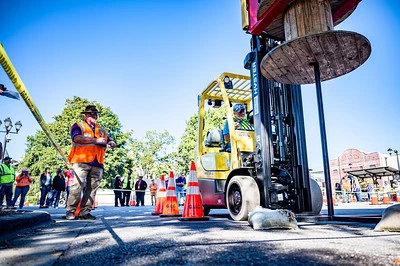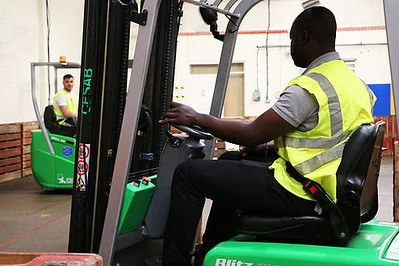Forklift License Requirements: What You Need to Have?
April 15, 2024 | by onlineoshasafetytraining.com


Forklifts are powerful tools used in many places like warehouses and construction sites to move heavy items. However, driving a forklift is not as simple as driving a car. To ensure safety, anyone who operates a forklift needs to have a special license. This license shows that the operator has learned how to use the forklift safely and has passed tests to prove their skills.
In this article, we will explain what are the requirements to obtain a forklift license, how to get one, and why it is important to follow these rules.
OSHA Regulation Requiring Operator to Have a Forklift License
The specific regulation by the OSHA that requires operators to have a forklift license falls under OSHA Standard 29 CFR 1910.178, specifically the 1910.178(l)(6). This standard outlines the requirements for the operation of powered industrial trucks, including forklifts. It specifies that employers must ensure that each operator is competent to operate a powered industrial truck safely, as demonstrated by the successful completion of training and evaluation specified in this standard.
The key components of the regulation include:
- Training Program: Operators must undergo formal (e.g., lecture, video, interactive computer learning), practical (demonstrations and practical exercises), and evaluation of operator performance in the workplace.
- Content of Training: Training should cover truck-related topics (like operating instructions, warnings, and precautions), and workplace-related topics (like surface conditions and load manipulation).
- Certification: Employers must certify that each operator has received and understood the training and has been evaluated. The certification must include the operator’s name, the date of training, the date of evaluation, and the identity of the person(s) performing the training or evaluation.
These requirements are designed to ensure that forklift operators are properly trained and evaluated on their abilities to operate forklifts safely, thus minimizing the risk of accidents and injuries in the workplace.
To prove that the operator is properly certified, he will be given a license or operator card at the end upon completion of the training and certification.
What Are The Training Requirements According to OSHA
According to OSHA, the training requirements for forklift operators are detailed and specific to ensure that all operators are properly trained in both the operation of the forklift and the specific conditions in their workplace where the forklift will be used. Here are the key components of OSHA’s forklift training requirements, as outlined in OSHA Standard 29 CFR 1910.178(l):
- Training Program Content:
- Truck-related topics: Such as operating instructions, warnings, and precautions for the types of trucks the operator will be authorized to operate; differences between the truck and the automobile; truck controls and instrumentation; engine or motor operation; steering and maneuvering; visibility; fork and attachment adaptation, operation, and use limitations; vehicle capacity and stability; any vehicle inspection and maintenance that the operator will be required to perform; refueling and/or charging and recharging of batteries; operating limitations.
- Workplace-related topics: Including surface conditions where the vehicle will be operated; composition of loads to be carried and load stability; load manipulation, stacking, and unstacking; pedestrian traffic in areas where the vehicle will be operated; narrow aisles and other restricted places where the vehicle will be operated; hazardous (classified) locations where the vehicle will be operated; ramps and other sloped surfaces that could affect the vehicle’s stability; closed environments and other areas where insufficient ventilation or poor vehicle maintenance could cause a buildup of carbon monoxide or diesel exhaust; other unique or potentially hazardous environmental conditions in the workplace that could affect safe operation.
- Types of Training:
- Formal Instruction: This can be lectures, discussions, interactive computer learning, videos, or written material.
- Practical Training: Includes demonstrations performed by the trainer and practical exercises by the trainee.
- Evaluation: An evaluation of the operator’s performance in the workplace.
- Certification:
- Upon completion of training and evaluation, employers must certify that each operator has been trained and evaluated as required by the standard. The certification must include the operator’s name, the date of training, the date of evaluation, and the identity of the person(s) performing the training or evaluation.
- Refresher Training and Evaluation:
- Refresher training, including an evaluation of the effectiveness of that training, is required to ensure that the operator has the knowledge and skills needed to operate the powered industrial truck safely. Refresher training is required if:
- The operator has been observed to operate the vehicle in an unsafe manner.
- The operator has been involved in an accident or near-miss incident.
- The operator has received an evaluation that reveals that the operator is not operating the truck safely.
- The operator is assigned to drive a different type of truck.
- A condition in the workplace changes in a manner that could affect safe operation of the truck.
- Refresher training, including an evaluation of the effectiveness of that training, is required to ensure that the operator has the knowledge and skills needed to operate the powered industrial truck safely. Refresher training is required if:
These training and evaluation requirements are crucial for ensuring that forklift operators are equipped with the necessary skills and knowledge to operate forklifts safely and efficiently, thereby reducing the risk of accidents and injuries in the workplace.
Age Requirements
The age requirement for operating a forklift and obtaining a forklift license can vary by country or even by state within a country. In the United States, the Occupational Safety and Health Administration (OSHA) sets the minimum age at 18 years old for forklift operators. This age limit is designed to ensure that forklift operators have the necessary maturity and physical capability to handle the demands and responsibilities of operating such equipment safely.
In other countries, the age requirements might be similar or could vary slightly depending on local laws and regulations. Employers are responsible for verifying that all operators meet the minimum age requirement and are properly trained and certified according to local regulations before allowing them to operate a forklift.
In the UK, Canada, and Australia, the age requirements for operating a forklift and obtaining a forklift license are set to ensure operators have reached a certain level of maturity and responsibility. Here’s a breakdown for each country:
- United Kingdom:
- The minimum age for operating a forklift is 16 years old. However, this is only applicable in certain controlled environments, such as ports or training centres. For most workplaces, particularly where the forklift operation is part of a broader job function like warehousing, the practical minimum age is often 18 due to insurance and health and safety guidelines.
- Canada:
- In Canada, the age requirement can vary by province, but generally, the minimum age for operating a forklift is 18 years old. Each province might have specific training and certification requirements, but they all require operators to be adults, primarily due to the responsibilities and safety implications involved in forklift operation.
- Australia:
- In Australia, the minimum age to obtain a forklift license is 18 years old. To get licensed, individuals must complete a training course from a registered training organization and pass a competency assessment.
These age requirements are part of broader regulations that include training and certification to ensure forklift operators are capable of handling their equipment safely and effectively, minimizing the risk of accidents in the workplace.
Physical Requirements of Forklift Operator
Operating a forklift requires a certain level of physical ability to ensure safe and effective handling of the equipment. Here are some of the key physical requirements typically expected of a forklift operator:
- Good Vision:
- Operators must have good vision to safely maneuver a forklift in various lighting conditions and environments. This includes adequate depth perception, peripheral vision, and the ability to adjust focus between near and distant objects.
- Hearing:
- Adequate hearing is necessary for detecting hazards that cannot be seen, hearing alarms, and being aware of other vehicles and personnel in the work area.
- Manual Dexterity and Coordination:
- Operators need good hand, foot, and eye coordination to manage the complex controls of a forklift. This includes the ability to operate levers, buttons, and pedals simultaneously and effectively.
- Physical Strength and Stamina:
- Some physical strength is required, particularly in handling loads, making adjustments to machinery, or managing the manual aspects of operating older models of forklifts. Stamina is also important, as operators may need to be in the forklift for extended periods.
- Flexibility and Balance:
- Operators should be able to maintain their balance and have the flexibility needed to twist and turn when looking behind them or maneuvering in tight spaces. They may also need to climb on and off the forklift multiple times during a shift.
- General Health:
- Being in good health helps ensure that the operator can handle the physical demands of the job and manage the mental acuity needed for safe operations. Operators should not be impaired by drugs, alcohol, or any medical conditions that could hinder their operational capabilities.
- Mental Alertness:
- Operating a forklift requires attention to detail and the ability to concentrate over long periods. Mental alertness is crucial to maintain safety standards and react quickly to potential hazards or unexpected situations.
Employers often conduct physical assessments during the hiring process to ensure that potential operators meet these requirements. Additionally, ongoing health assessments may be part of an operator’s career to ensure they remain capable of performing their duties safely. These physical requirements are designed to minimize the risk of accidents and injuries, ensuring a safe working environment for everyone involved.
What Are The Information Need To Be In the Forklift License
A forklift license, also known as a forklift operator certification, typically contains specific information that verifies the identity of the operator and their qualifications to operate a forklift. This information is crucial for ensuring that only trained and evaluated individuals operate these vehicles. Here’s a breakdown of the essential details that are usually included on a forklift license:
- Operator’s Name: The full name of the individual certified to operate the forklift.
- Operator’s Photo: A recent photograph to visually identify the operator.
- License Number: A unique identifier or license number that can be used to verify the authenticity of the license and retrieve operator records.
- Date of Issue: The date when the license was issued after successful completion of training and evaluation.
- Expiration Date: The date when the license will expire and require renewal. Forklift certifications typically need to be renewed every three years, but this can vary based on company policy or local regulations.
- Types of Forklifts Authorized to Operate: Specific types of powered industrial trucks that the operator is certified to handle (e.g., counterbalance, reach truck, pallet jack).
- Restrictions or Limitations: Any restrictions based on the operator’s training or evaluation results, such as certain types of loads or operating environments.
- Issuing Organization: The name of the training provider or the certifying body that conducted the training and evaluation.
- Instructor’s Name/Signature: The name and signature of the instructor or evaluator who certified the operator’s competence.
- Additional Training Completed: Details of any additional or specialized training the operator has completed, such as hazardous material handling.
This information helps employers and safety inspectors ensure that all forklift operators on site are properly trained and authorized to operate the equipment, reducing the risk of accidents and improving overall safety in the workplace.
How to Get One
Getting a forklift license involves several steps that are designed to ensure operators have the necessary skills and knowledge to safely operate a forklift. Here’s a general guide on how to obtain a forklift license:
- Meet the Minimum Age Requirement:
- Ensure you meet the minimum age requirement, which is typically 18 years old in most countries.
- Complete a Forklift Training Course:
- Enroll in a certified forklift training program. These programs are offered by various organizations, including vocational schools, community colleges, and private training providers. The training usually covers both practical skills and theoretical knowledge.
- Undergo Classroom Instruction:
- Attend classroom lectures that cover all aspects of forklift operation, including safety protocols, laws, and maintenance. Topics often include OSHA regulations, operating controls, steering, maneuvering, load handling, and vehicle stability.
- Participate in Hands-On Training:
- Engage in practical training where you learn to operate a forklift under supervised conditions. This part of the training is crucial as it provides you with real-life operating experience.
- Pass the Evaluation:
- After completing the training, you must pass a skills evaluation conducted by a certified instructor. This test usually includes a written exam and a practical test of your ability to operate a forklift safely.
- Receive Your Forklift Certification:
- Once you pass both the written and practical tests, you will receive your forklift certification. This certification might be issued by the training provider and should include your name, the date of training, the expiration date, and the types of equipment you are certified to operate.
- Maintain and Renew Certification:
- Forklift certifications are not indefinite; they typically need to be renewed every three years. Renewal often requires additional training or refresher courses, especially if you have not operated a forklift for a while, or if there are updates to OSHA regulations or new technologies in forklift operation.
- Stay Informed:
- Keep up-to-date with any changes in forklift operation standards or safety regulations. Continuous learning and adherence to safety practices are essential for maintaining a safe working environment.
Following these steps will help you obtain the necessary certification to operate a forklift legally and safely in a professional setting.
To Make a Conclusion
Forklift license requirements are crucial for ensuring that anyone operating a forklift is properly trained and certified. This process involves learning how to safely use the forklift, passing tests to prove your skills, and getting a certificate. This certificate is not just for show; it confirms that you understand how to operate a forklift safely, protecting both you and your coworkers. It’s important to keep this certification current by renewing it as needed and staying up-to-date with safety practices.
RELATED POSTS
View all


